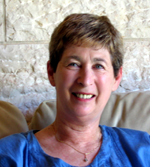By Dorothea Shefer-Vanson

MEVASSERET ZION, Israel — Undergoing medical tests of various kinds invariably involves spending what seems like endless hours hanging around in hospital waiting rooms and corridors.
Strange as it may seem, the most sophisticated modern medical procedures, engaging equipment almost equivalent to the engine of a jet fighter plane, require imbibing quantities of unpalatable liquids and many hours of waiting, both before and after the procedure.
However, the conditions in which one waits for a CT (CAT scan), at least in Jerusalem’s Hadassah Hospital, can only be defined as something less than salubrious.
A drafty corridor, a few plastic chairs that are insufficient for the number of people waiting to be dealt with, the constant passage of hospital personnel, orderlies wheeling patients in their beds, visitors and sundry passersby, many of them talking loudly on cell phones, provides the setting as one waits for the ultra-modern medical procedure. A small TV screen set high on one of the opposing walls is tuned constantly to the children’s channel, adding further discomfort to the waiting experience.
A minor consolation while one waits is offered by the opportunity to review the varied population that is undergoing the same unpleasant process. Sometimes there is a sense of fellow-feeling among those waiting, while at others a sense of rivalry pervades the atmosphere. Some people seem to be able to get ahead of others in the queue, and those left behind are justifiably resentful, and make no bones about venting their feelings. Occasionally, conversations develop between those left behind, as accompanying persons commiserate with one another about the lengthy wait, the trials and tribulations of even obtaining an appointment in the first place, and the hassle of having to travel long distances in order to get to the hospital, which serves a wide area of Israel.
What seems like an entire Arab clan accompanies an elderly gentleman who is awaiting his turn; a nun wearing a short grey habit and a head-covering that parallels the headdress of religious women of both the Moslem and the Jewish religion accompanies a tall, fair-haired woman who speaks only French; an elderly religious couple focus on the books of psalms in their hands, and assorted men and women of all ages and from all walks of life stare blankly into space, read books or follow the programmes on the children’s TV channel with avid interest. A well-dressed young woman accompanying an older version of herself in a wheelchair conducts an animated conversation in Russian with the attendant nurse, while orderlies stroll past chatting amiably about Facebook in Arabic (I don’t speak Arabic, but I could understand the word ‘Facebook’).
What the hospital waiting corridor presents is a veritable microcosm of Israel’s population in all its various aspects. The conversations, the clothing, the languages spoken, and the general appearance of the assorted individuals waiting in the corridor present a reflection of everything that is both good and bad about Israel’s population – its variety, its sense of fellowship, its rivalries, and its reluctant acceptance of the inevitable.
*
*
Dorothea Shefer-Vanson is a freelance writer, author, and translator based in the Jerusalem suburb of Mevasseret Zion. She may be contacted via dorothea.shefer@sdjewishworld.com